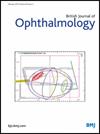Persistent socioeconomic disparities and delayed onset in blindness due to neonatal disorders: global burden and future projections
IF 3.5
2区 医学
Q1 OPHTHALMOLOGY
引用次数: 0
Abstract
Objective Blindness, a significant complication of neonatal disorders (ND) and their four subtypes, profoundly impacts individuals’ quality of life. This study assesses the global burden of blindness caused by ND to inform health policy development. Methods Data were obtained from the Global Burden of Disease Study 2021 (GBD 2021). Age-standardised prevalence and years lived with disability (YLDs) were analysed using estimated annual percentage changes (EAPCs) and joinpoint model. Health disparities were evaluated through Sociodemographic Index (SDI) via the Slope Index of Inequality (SII) and Concentration Index (CI). Decomposition analysis identified burden changes, and Bayesian age-period-cohort (BAPC) models projected trends through 2040. Results In 2021, global ND-related blindness cases exceeded 4.26 million, reflecting a 60.92% increase in prevalence and 61.33% rise in YLDs since 1990. Age-standardised prevalence rates (ASPR) and YLDs rates (ASYR) increased, with the EAPCs of 0.29 (95% CI 0.26 to 0.32) and 0.31 (95% CI 0.28 to 0.34), respectively, primarily driven by population growth and epidemiological change. Socioeconomic disparities persisted, with higher burdens in lower SDI regions. From 2005 to 2021, prevalence peaked in the 45–54 age group. Projections to 2040 indicated contrasting trends: a decline in prevalence based on 1990–2021 trends, but a slight increase based on 1990–2019 trends, prior to the COVID-19 pandemic. Conclusions The burden of ND-related blindness remains substantial. The heavier burden in low SDI regions and the delayed onset of blindness due to the cumulative effects of ND may be underestimated. Urgent improvements in medical resource allocation and long-term eye health follow-up for ND survivors are needed. Data are available upon reasonable request. Some of the data presented here are publicly available on the Global Health Data Exchange website. The other data and analysis code are available from the corresponding author upon reasonable request.持续的社会经济差异和新生儿疾病引起的延迟性失明:全球负担和未来预测
失明是新生儿疾病(ND)及其四亚型的重要并发症,严重影响个体的生活质量。本研究评估由ND引起的全球失明负担,为卫生政策制定提供信息。方法数据来自全球疾病负担研究2021 (GBD 2021)。使用估计年度百分比变化(EAPCs)和连接点模型分析年龄标准化患病率和残疾生活年数(YLDs)。通过社会人口指数(SDI)、不平等斜率指数(SII)和浓度指数(CI)评估健康差异。分解分析确定了负担变化,贝叶斯年龄-时期-队列(BAPC)模型预测了到2040年的趋势。结果2021年,全球nd相关性失明病例超过426万例,与1990年相比,患病率上升了60.92%,YLDs上升了61.33%。年龄标准化患病率(ASPR)和YLDs率(ASYR)增加,eapc分别为0.29 (95% CI 0.26 ~ 0.32)和0.31 (95% CI 0.28 ~ 0.34),主要受人口增长和流行病学变化的驱动。社会经济差异仍然存在,低SDI地区的负担更高。2005年至2021年,45-54岁年龄组的患病率达到高峰。到2040年的预测显示出截然不同的趋势:根据1990-2021年趋势,患病率有所下降,但在2019冠状病毒病大流行之前,根据1990-2019年趋势,患病率略有上升。结论nd相关性失明的负担仍然很大。低SDI地区较重的负担和ND累积效应导致的延迟致盲可能被低估了。迫切需要改善医疗资源分配和ND幸存者的长期眼健康随访。如有合理要求,可提供资料。这里介绍的一些数据可在全球卫生数据交换网站上公开获得。其他数据和分析代码可根据合理要求从通讯作者处获得。
本文章由计算机程序翻译,如有差异,请以英文原文为准。
求助全文
约1分钟内获得全文
求助全文
来源期刊
CiteScore
10.30
自引率
2.40%
发文量
213
审稿时长
3-6 weeks
期刊介绍:
The British Journal of Ophthalmology (BJO) is an international peer-reviewed journal for ophthalmologists and visual science specialists. BJO publishes clinical investigations, clinical observations, and clinically relevant laboratory investigations related to ophthalmology. It also provides major reviews and also publishes manuscripts covering regional issues in a global context.

 求助内容:
求助内容: 应助结果提醒方式:
应助结果提醒方式:


